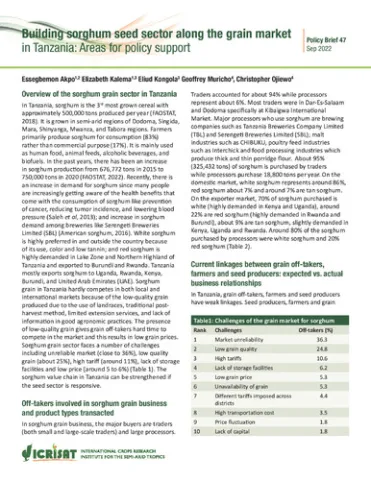Building sorghum seed sector along the grain market in Tanzania: Areas for policy support

Abstract
In Tanzania, sorghum is the 3rd most grown cereal with approximately 500,000 tons produced per year (FAOSTAT, 2018). It is grown in semi-arid regions of Dodoma, Singida, Mara, Shinyanga, Mwanza, and Tabora regions. Farmers primarily produce sorghum for consumption (83%) rather than commercial purpose (17%). It is mainly used as human food, animal feeds, alcoholic beverages, and biofuels. In the past years, there has been an increase in sorghum production from 676,772 tons in 2015 to 750,000 tons in 2020 (FAOSTAT, 2022). Recently, there is an increase in demand for sorghum since many people are increasingly getting aware of the health benefits thatcome with the consumption of sorghum like prevention of cancer, reducing tumor incidence, and lowering blood pressure (Saleh et al, 2013); and increase in sorghum demand among breweries like Serengeti Breweries Limited (SBL) (American sorghum, 2016). White sorghum is highly preferred in and outside the country because of its use, color and low tannin; and red sorghum is highly demanded in Lake Zone and Northern Highland of Tanzania and exported to Burundi and Rwanda. Tanzania mostly exports sorghum to Uganda, Rwanda, Kenya, Burundi, and United Arab Emirates (UAE). Sorghum grain in Tanzania hardly competes in both local and international markets because of the low-quality grain produced due to the use of landraces, traditional postharvest method, limited extension services, and lack of information in good agronomic practices. The presence of low-quality grain gives grain off-takers hard time to compete in the market and this results in low grain prices. Sorghum grain sector faces a number of challenges including unreliable market (close to 36%), low quality grain (about 25%), high tariff (around 11%), lack of storage facilities and low price (around 5 to 6%) (Table 1). The sorghum value chain in Tanzania can be strengthened if the seed sector is responsive.
